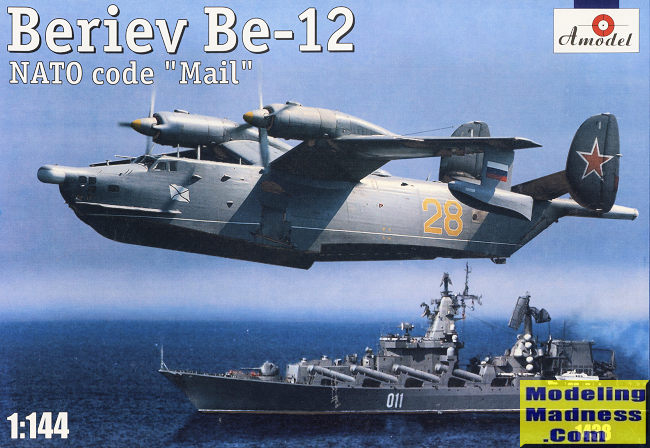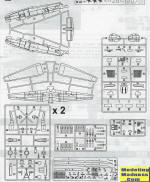
| KIT #: | 1438 |
| PRICE: | $59.95 SRP (on sale for considerably less) |
| DECALS: | Five options |
| REVIEWER: | Scott Van Aken |
| NOTES: | Includes p.e. fret |

| HISTORY |
The Be-12 entered service with Soviet Naval Aviation, or AV-MF (Aviatcia Voenno-Morskogo Flota), in the early 1960s in the maritime patrol role, and is one of the few amphibians still in military service in the world. Initially its role was ASW patrol, but when newer missiles enabled United States Navy submarines to launch from further offshore it was converted to the search and rescue role (Be-12PS). Small numbers are still in service. After the dissolution of the Soviet Union, some aircraft were converted to water bombers for the suppression of forest fires. During development of the Beriev Be-200 unique fire-fighting equipment was tested using a specially modified Be-12P, code-named "12 Yellow". After installation of the fire-fighting system, the aircraft was registered as RA-00046 and given the designation Be-12P-200. This modified Be-12 was also used to trial firefighting operations envisaged for the Be-200. According to figures released in 1993, the Russian Navy had 55 aircraft in service. By 2005 this had dropped to 12, and by 2008 there were only nine aircraft still in service. A surviving Be-12 is preserved at the Central Air Force Museum at Monino, outside of Moscow. Other examples exist at the Ukraine State Aviation Museum at Kiev, Ukraine and at the Taganrog Air Museum, in southern Russia. It has been reported that the planes have been conducting patrols of the Crimean coast in the context of the 2022 Russian invasion of Ukraine.
| THE KIT |
 Amodel
kits are basically good short run kits. My experience with them has been that
you can build a nice model with them if you put in sufficient effort and have
the skills to deal with the somewhat vague instructions.
Amodel
kits are basically good short run kits. My experience with them has been that
you can build a nice model with them if you put in sufficient effort and have
the skills to deal with the somewhat vague instructions.
I found a fair number of sink areas on large pieces,
but no flash and there are multiple mold gates to deal with on larger parts like
the wings and fuselage. A photo etch fret is included that provides a lot of
smaller or thin parts like the various fuselage strakes, ant ennas,
mooring lines, landing gear door attachment hinges and such. I was somewhat
surprised that there is no wheels up option with this one, though an
enterprising modeler should be able to work around that.
ennas,
mooring lines, landing gear door attachment hinges and such. I was somewhat
surprised that there is no wheels up option with this one, though an
enterprising modeler should be able to work around that.
First step is the cockpit with seats, control yokes and instrument panel. Immediately one attaches the cockpit clear piece. The builds the forward clear piece, tail gear, main wheels and wheel wells. The wells are then installed into the fuselage halves along with the fuselage side windows. The MAD boom is built and after the fuselage halves trap the tail gear the boom is attached. I'd suggest prepainting the fuselage before dealing with the windows. Then the tailplanes are attached and the cockpit section along with the clear nose piece is installed.
Floats are built in preparation for installing on the wing. Engine nacelles are then built as are the props. It looks like you can install the props after painting so that is nice. The wings are assembled and the nacelles attached along with the floats. Then the exhaust are attached and the wing fits onto the fuselage.
Next steps are the truly fussy ones as all those thing brass strakes along with the main gear bits and the doors are attached. A lot of the small brass pieces are used in building up the landing gear. A poor design is that the lower part of the main gear that holds the wheel is a butt join to the upper portion. Why this wasn't one piece is beyond me but will cause a lot of trouble and I doubt it will hold up to much handling.
Next all the underside stuff along with the tail gear
doors are attached. Instructions show two weapons racks per wing. However, there
are no holes to open up to install them and no indication of just where they
fit. You'd have to cut off the mounting posts from the racks and put them where
y ou think
they should fit. A number of weapons are included to use including depth bombs,
torpedoes and standard bombs. Finally, a myriad of etched antennas are fit to
the upper surface of the fuselage. The builder will need to stretch some sprue
or use wire for the pitot tubes.
ou think
they should fit. A number of weapons are included to use including depth bombs,
torpedoes and standard bombs. Finally, a myriad of etched antennas are fit to
the upper surface of the fuselage. The builder will need to stretch some sprue
or use wire for the pitot tubes.
Instructions are fair but sometimes vague. Humbrol color references are used. Five markings options are provided, all in overall light sea grey. Two are from Ukraine and the other three are Russian. The decal sheet is nicely done and should provide no issues.
| CONCLUSIONS |
This is an interesting kit and while it won't be an easy build, will provide a nice model for one's display shelves. Amodel also does this in 1/72 for those who want something bigger.
| REFERENCES |
https://en.wikipedia.org/wiki/Beriev_Be-12
August 2022
Copyright ModelingMadness.com. All rights reserved. No
reproduction in part or in whole without express permission from the editor.
If you would like your product reviewed fairly and fairly quickly, please
contact the editor
or see other details in the
Note to
Contributors.